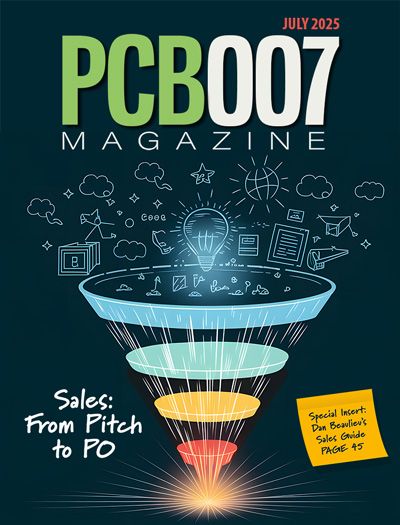-

- News
- Books
Featured Books
- pcb007 Magazine
Latest Issues
Current Issue
Advancing the Advanced Materials Discussion
Moore’s Law is no more, and the advanced material solutions to grapple with this reality are surprising, stunning, and perhaps a bit daunting. Buckle up for a dive into advanced materials and a glimpse into the next chapters of electronics manufacturing.

Inventing the Future With SEL
Two years after launching its state-of-the-art PCB facility, SEL shares lessons in vision, execution, and innovation, plus insights from industry icons and technology leaders shaping the future of PCB fabrication.

Sales: From Pitch to PO
From the first cold call to finally receiving that first purchase order, the July PCB007 Magazine breaks down some critical parts of the sales stack. To up your sales game, read on!
- Articles
- Columns
- Links
- Media kit
||| MENU - pcb007 Magazine
Estimated reading time: 2 minutes
The Shaughnessy Report: Trace Oddity
Remember when PCBs were all shaped like squares and rectangles? Things were so much simpler in the olden days.
Now boards are designed, fabricated and assembled in all shapes, including stars, human hands, octopuses, triangles, and cursive signatures, just to name a few. The wearables and automotive segments are driving the development of PCBs in odd shapes. And there are plenty of circular PCBs being designed for use in products that can reach out and touch bad actors in another part of the world.
Unconventionally shaped circuit boards bring with them a variety of potential missteps, mistakes, and miscues. Signal integrity and EMI can be big issues; strange geometries hamper a designer’s ability to lay out matched impedance traces. Understanding manufacturing and environmental tolerances is paramount.
There are also dozens of DFM, DFA, and DFT challenges with oddly shaped boards. Placing components on round boards or boards with a rounded side is a tricky matter, because some parts must be rotated at crazy angles to follow the curve of the PCB’s edge. Most autorouters are not optimized for routing parts at angles other than 90 or 45 degrees. Acute angles are more likely to lead to acid traps when a traditional router encounters pads that are not in the standard orthogonal shape. Odd-shaped boards also pose panelization and depanelization issues.
Designing boards in crazy shapes often requires PCB designers to import data from an MCAD tool into their ECAD tools. If you’ve been designing with 2D ECAD tools for decades, you might have to learn how to work with 3D MCAD tools, which are integrated with most EDA tools.
In this issue of Design007 Magazine, we will discuss some of the challenges, pitfalls, and mitigations to consider when designing non-standard board geometries. We will share strategies for designing odd-shaped PCBs, including manufacturing trade-offs and considerations required for different segments and perspectives.
In our expert's interview this month, Kris Moyer and Kelly Dack provide an overall look at designing PCBs in unconventional shapes. Then Stephen Chavez explains how EDA tool companies approach the design of oddly shaped boards. John Watson points out the need for designers to focus on physics when designing non-standard boards, and Kelly Dack’s column focuses on the need to understand dimensioning and tolerancing when working with offbeat board shapes. We also have columns from Matt Stevenson and Barry Olney, as well as articles by Anaya Vardya and Chris Keirstead.
It's been a busy year. I'll see you in 2024!
More Columns from The Shaughnessy Report
The Shaughnessy Report: Watt About Power Integrity?The Shaughnessy Report: Winning the Signal Integrity Battle
The Shaughnessy Report: A Plan for Floor Planning
The Shaughnessy Report: Showing Some Constraint
The Shaughnessy Report: Planning Your Best Route
The Shaughnessy Report: Solving the Data Package Puzzle
The Shaughnessy Report: Always With the Negative Waves
The Shaughnessy Report: Breaking Down the Language Barrier


